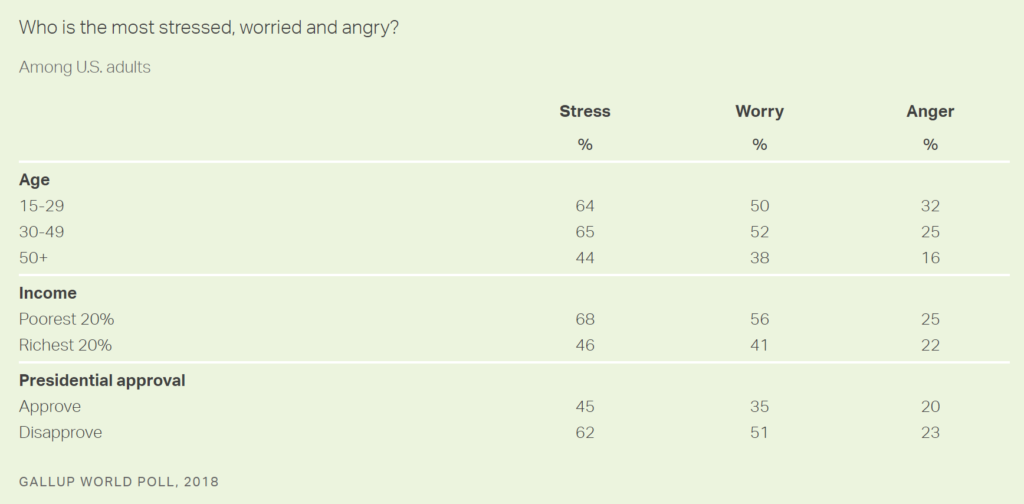Americans’ stress, worry, and anger reached highest recorded levels in 2018

By Julie Ray
25 April 2019
WASHINGTON, D.C. (Gallup) – Even as their economy roared, more Americans were stressed, angry, and worried last year than they have been at most points during the past decade. Asked about their feelings the previous day, the majority of Americans (55%) in 2018 said they had experienced stress during a lot of the day, nearly half (45%) said they felt worried a lot and more than one in five (22%) said they felt anger a lot.
Each of these figures matches or tops previous highs in the U.S. Additionally, Gallup’s latest annual update on the world’s emotional state shows Americans were more likely to be stressed and worried than much of the world. In fact, the 55% of Americans who experienced stress was one of the highest rates out of the 143 countries studied and it beat the global average (35%) by a full 20 percentage points. The U.S. even ties statistically with Greece, which has led the world on this measure every year since 2012.
When it comes to worry, the six-point gap between the U.S. (45%) and the global average (39%) was not nearly as substantial as it was with stress. The U.S. was also far from the top of the list of countries with the largest worried populations. In 29 countries, a majority of people said they worried a lot the previous day, including at least six in 10 in places such as Mozambique (63%), Chad (61%) and Benin (60%).
And, even though more Americans were angry last year than most years in the past, the 22% who were angry was the same as the global average. Americans, as a whole, were half as likely to be angry as the populations of the Palestinian Territories (43%), Iran (43%), Iraq (44%), and Armenia (45%).
Which Americans Are Most Stressed, Worried or Angry?
Younger Americans between the ages of 15 and 49 are among the most stressed, worried and angry in the U.S. Roughly two in three of those younger than 50 said they experienced stress a lot, about half said they felt worried a lot and at least one in four or more felt anger a lot.

Income also plays a role with worry and stress, with the lowest income Americans carrying more of the emotional burden than the highest income Americans. Nearly seven in 10 Americans in the poorest 20% of the population said they experienced stress the previous day, compared with less than half (48%) of Americans in the richest 20%. Similarly, 56% of Americans in the poorest group said they worried a lot, compared with 41% in the richest group.
And, although Gallup does not ask about political affiliation in its World Poll, there was also a strong relationship between stress, worry and disapproval of the job that President Donald Trump is doing. Those who disapprove of Trump’s job performance are significantly more likely to experience each of these negative emotions than those who do.
Bottom Line
The world took a negative turn in 2017, with global levels of stress, worry, sadness and pain hitting new highs. During a solid year of economic growth, the U.S. kept this negative trend going into 2018. Higher levels of stress, anger and worry nudged Americans’ overall Negative Experience Index to 35 — three points higher than any previous score to date.
The disconnect between a strong economy and Americans’ increasing negative emotions illustrates how GDP and other hard economic data only tell part of the story. In fact, the levels of negative emotions in the past several years are even higher than during the U.S. recession years. Given the ties that researchers are starting to find between negative affects like these and physical health and longevity, leaders need the whole story.
Read the full Gallup 2019 Global Emotions Report.